JOSHUA NORDSTROM, Tierra Tile, LLC
Editor note: This section gives us a chance to visit with our NTCA Tile Setter Craftspeople of the Year to get their insights on craftsmanship and artisanship. This issue, artisan tile setter extraordinaire Joshua Nordstrom – who was awarded the award in the residential category – shares his perspective on his life’s work and passion.
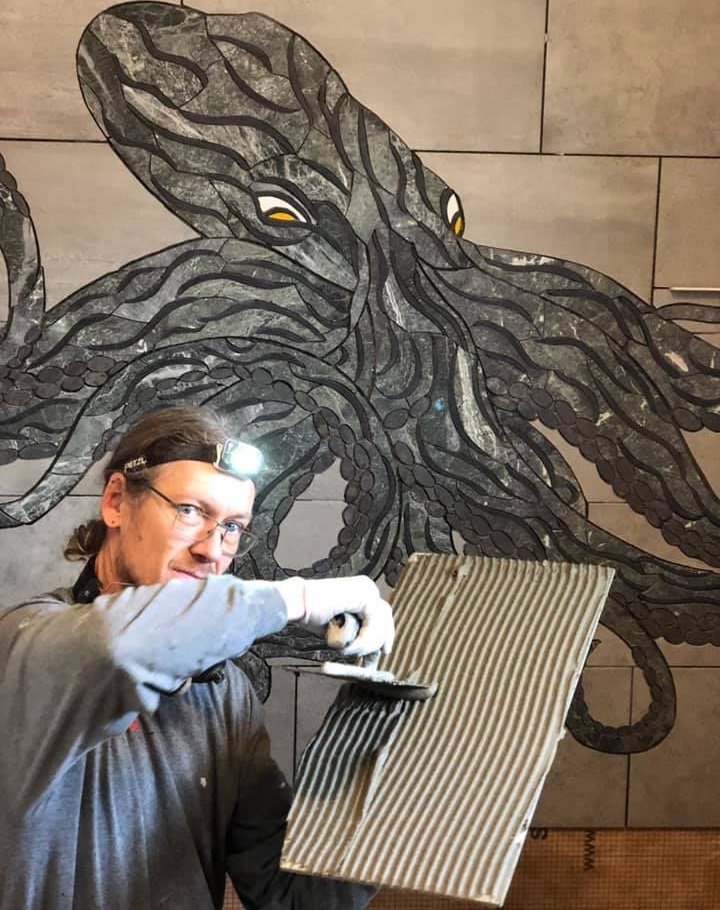
What does artisan tile setting mean to me? It’s my life. It’s my love. It’s my passion.
It’s a personal touch to a tile installation that allows you to step out of gridded grout lines to add an element of art in mosaic form. Kinda like a tattoo, I guess. For your home.
I started out making mosaics from scratch. I took a few pottery classes in high school and found a love for it. After graduating, I had the opportunity to make some tiles for a friend’s apartment entryway and stair risers. Working in the construction industry, I saw an opportunity to make mosaic tiles for people’s homes.
A few years later, I figured being a tile contractor would help sell the mosaics, so I began to learn how to set tile. Early on, I realized that making mosaics from scratch was super time consuming and hard to receive adequate pay for the time invested. I made a few things for friends and family before I stumbled on cutting store-bought manufactured tile. I was doing a big travertine bathroom and the homeowner gave me some creative freedom. So I cut a bunch of “chevrons” for a repetitive floor base trim and found that cutting shapes out of stone was easier than making them out of clay. This is also when I first stumbled upon pre-mounting. I think I just used some blue drywall mesh tape and liquid membrane.
From meticulous to magical
A craftsperson is just a fancy word for being meticulous, detail oriented, and working with your hands. Anyone can be a craftsperson at anything they set their mind to do. I think that you have to have a love for what that is to be a true craftsperson. It always starts small and organically grows bigger as projects go by and experience is gained. You’re always trying to top the last one and make it a little bit better, learning from mistakes and making changes along the way. Traditional tile setting is a very detail-oriented trade to begin with. You need that special eye for detail to be a decent tile setter, so there’s already that connection. You just need to be willing to step out of the gridded grout lines or the “box” a little bit and try something different.


Dancing Cranes
Nordstrom created an entryway of the dancing cranes that migrate back to this homeowner’s property every year.
Challenges: part of the job
There are always challenges with every job, no matter what scale it is. I think pricing is the number one challenge. That could be said about any job, being “traditional” or artisan. Estimating the time that it takes to create, fabricate and install an artisan piece along with the materials needed and receiving a fair price has been a challenge on pretty much every job that I have done. Experience is an answer to that problem. The more you do, the more you learn.
You need to be willing to sacrifice some time to gain this experience. I started making things for friends and family to gain the experience. As time goes on and jobs go by, you start to learn a sense of time that goes into a project.
Another challenge is to design within a given budget. It’s real easy to over-design something and make it more complicated than the budget allows. This may be due to me always wanting to outdo the last project. What really matters is making the client happy. That’s the whole intent.
Sandhill Crane
This Sandhill crane is cut completely from white subway tile, with the exception of red glass accenting its head. The owner wanted a subtle depiction of the crane.
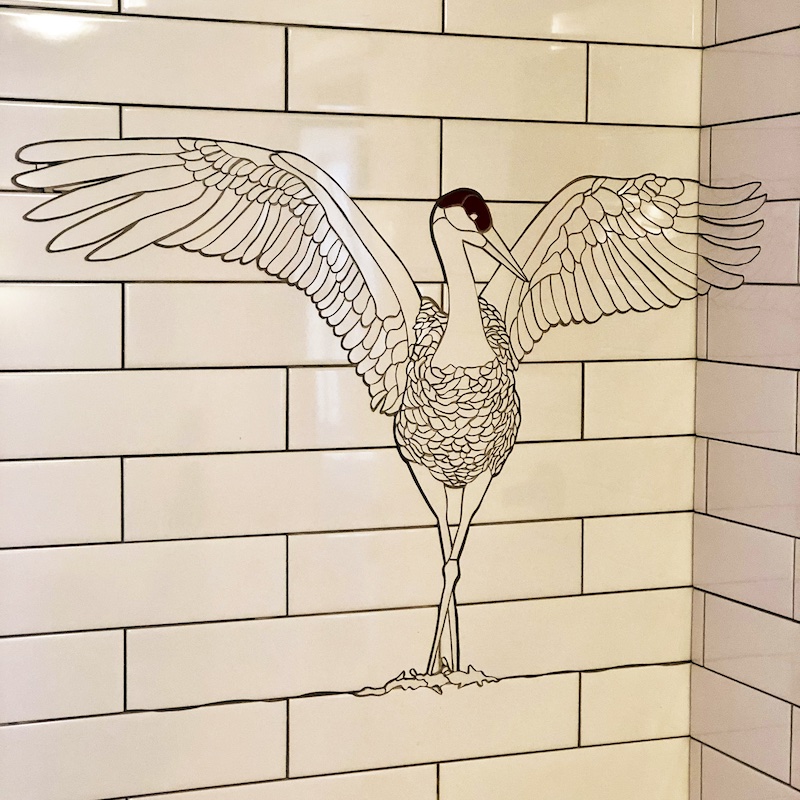

Training ups your game; apprenticeship helps too
It seems that most manufacturers these days offer training. There is training in every aspect of the industry. The NTCA offers numerous training programs nationwide. There’s large panel porcelain training, art glass panel training, mud training, artisan training – the list goes on. Also webinars and podcasts. A “mind training” of sorts. All you need to do is listen. I would recommend attending some of these as any information is valuable information. Even if you already know how something is done there’s always something new to take away from it.
If you’re able to find an apprenticeship, this will fast track you to become a more successful tile craftsperson. I did not have this option since everything that I learned was self-taught and took many years to develop. Being an apprentice for someone who has knowledge of the trade and teaches the right way is unmeasurable.


Kachemak Bay
Nordstrom customized this backsplash with a view of the mountains above Kachemak Bay rendered in travertine, marble and slate. This view was precious to the homeowner who used to fish in the bay.
Pride, joy, a livelihood – and seeing the legacy carried to a new generation
There are many benefits to being a tile craftsperson. For me number one is a sense of pride in my work. It’s truly gratifying to see the look on my clients’ faces when a job is completed. Overcoming the challenges faced on a challenging installation is a pretty good feeling. Of course there’s the benefit of money. The more knowledge and experience means the more you’re worth. You just need to find the market that you are happy working in and making a go of it.
Doing a quality tile installation is rewarding to me. Seeing the joy on a client’s face and overcoming the challenges that got me there is gratifying. The most rewarding thing of being a craftsperson is the sense of pride of seeing a job come to completion.
Witnessing other tile setters developing their artistic styles is also very rewarding to me. I love to see the style changes in our industry. Tile has been pretty stale for quite a long time, and seeing people’s creativity I think is inspiring to most people. The enthusiasm and drive that some are showing is infectious.
We had our first artisan training program A.R.T: Artisans Revolution in Tile last year and a handful of attendees have taken it upon themselves to share what they had learned at Coverings this year and at TileFest this month at the TileWorks in Doylestown, Pa. It’s exciting to see the training through the eyes of the trained. I’m really proud of what they’re doing, sharing their knowledge and helping the industry move forward in an artisan direction.
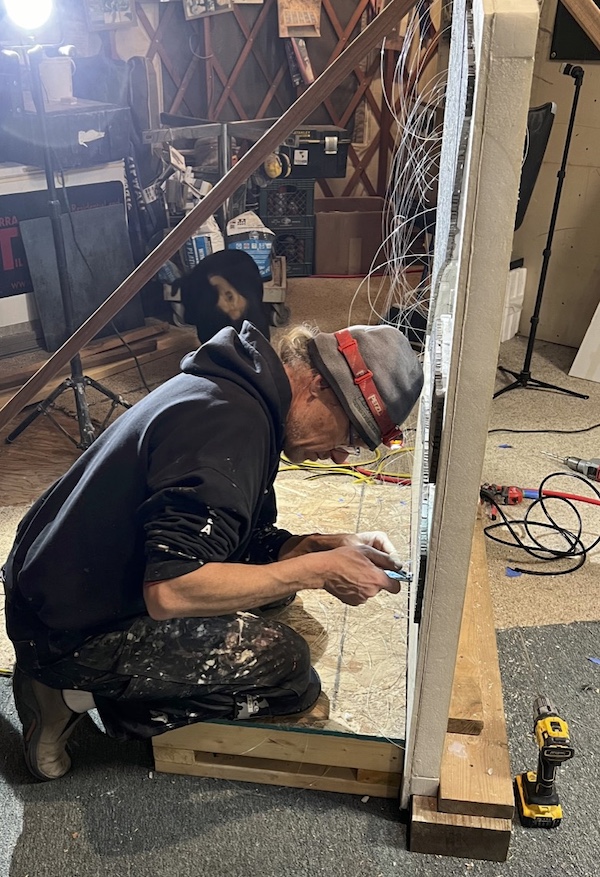

Glowing Mosaic
The inspiration for this Aurora mosaic came last winter when there was amazing aurora activity in Alaska. Nordstrom’s client approached him with a request for a mosaic at that time, and Nordstrom pitched the idea of an 8 ft. aurora mosaic to be backlit with fiber optics. The project actually grew to 16 ft. Nordstrom made some scaled down samples, and purchased a small fiber optic unit to illuminate the stars – and learned on the job how to work with it, including jettisoning the original plan to use super glue on the 2″ LATICRETE Hydro Ban board in favor of hot glue. Nordstrom had to determine how much dead air space was needed for the illumination he wanted for the aurora since it needed a packet of thicker fibers to light up the aurora from the sides of the cable. The stars needed less space since they were lit up with an end glow fiber – or the tip of the fiber optic cable. After multiple consultations with fiber optic consultants – and assistance from son Halen for the install – he fine tuned this project to an incredible glowing mosaic to the delight of his client.
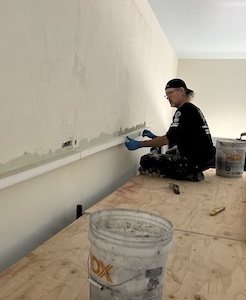

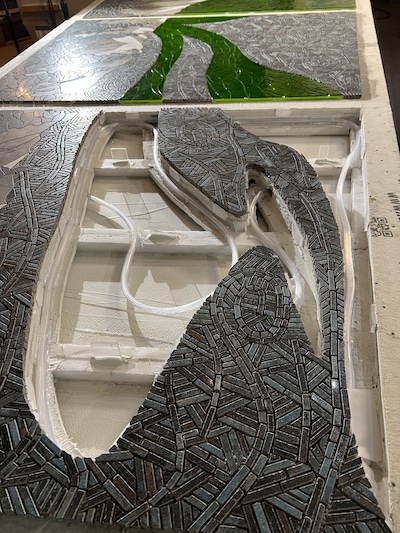

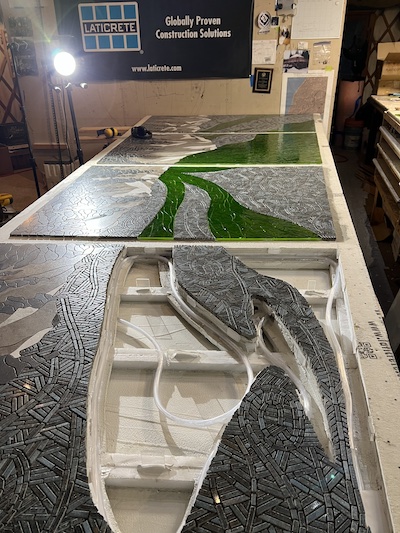

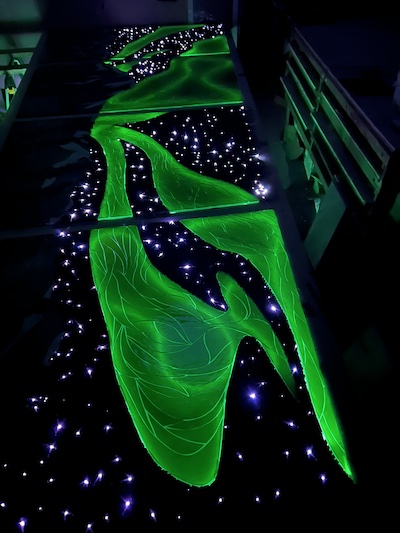

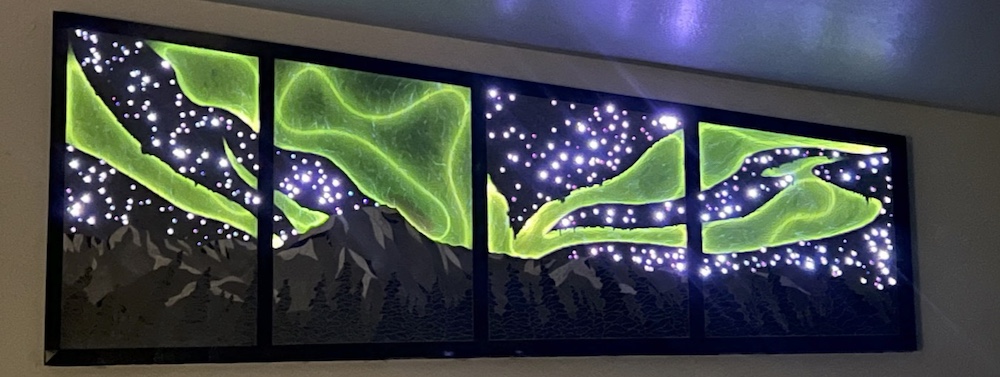

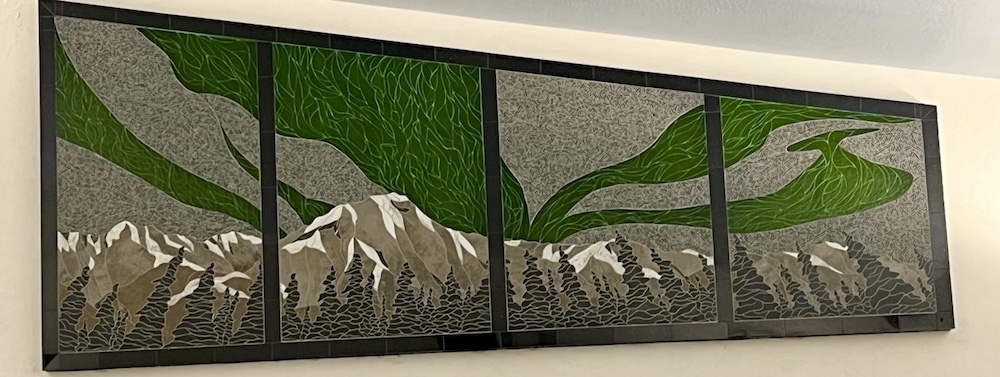

A.R.T. training take two: next month in Milwaukee
Prepping and setting tile is not easy. It requires a special eye for detail and I believe that any tile setter is already an artist of some level. The A.R.T program, sponsored by NTCA and LATICRETE and held at Dragonfly Tile and Stone Works in Milwaukee next month, is designed to take that to the next level. Attendees will be taught how to conceive, sell, fabricate, and install an artisan mosaic piece into their everyday tile installations. They will be taught proper methods and the steps taken to successfully make a handcrafted mosaic. And in just four days, they’ll also learn the dos and don’ts that have taken over 20 years to figure out.
A.R.T. Training is set up to be a hands-on interactive class where everyone will be on tools all of the time. Everyone will take home their own mosaic at the end of the week along with much knowledge. We are going on year two and witnessing what the first year students are now creating is really rewarding. They have certainly taken their skills to the next level and have become true tile artisans. I really love tile and am excited to be part of the Artisans Revolution in Tile. (Ed note: want information on upcoming A.R.T. classes? Join the Tile Trade Artisans Guild on Facebook to be the first to know about new classes and opportunities.)






